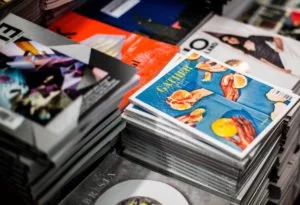Clients want vibrant and visually appealing prints, and many printing businesses can provide this. However, no matter how skillfully designed and well-made an image, logo, or any digital artwork can be, using the wrong kind of paper for printing can decrease or ruin its quality.
So, it’s always important to know what kind of paper to use for certain projects. Here’s a guide on how to choose paper for printing.
Paper Weight
The definition of paper weight can vary between countries, but generally speaking, it comes from its mass and stiffness. Heavier paper tends to be thicker and stiffer, while lighter papers are more flexible and brittle.
It’s important to consider weight and thickness because thicker paper tends to be sturdier and rugged, making it good for printed materials that require sturdiness and long-term use. In conferences, for example, people are more likely to hold a program fold with a thicker board than a thinner one because it can withstand the regular wear and tear compared to thinner papers. Or in another example, it’s recommended that you create your own business card with thicker paper so that it can be durable and withstand external elements so that potential clients can keep your card until they need it.
Heavier papers are often used for:
- Paperback/softcover books
- Greeting cards
- Gift tags
- Gift envelopes
- Brochures
On the other hand, softer papers (also known as text stock) are used for:
- The pages inside the books
- Desktop printing
- Flyers and pamphlets
- Sticker paper
- Everyday printing
Paper weight plays a huge role on a printed item’s effectiveness, longevity, and function. For example, paper tabletops in restaurants require thicker, heavier paper if restaurant owners want these tabletops to last longer than just one customer. On the other-hand, single-use paper placemats are much lighter and thinner because these are designed to be one-use.
There’s also the practical aspect of choosing based on paper weight. When businesses ship letters to their clients and customers, heavier papers may cost more to send, which could lead to higher costs. But on the other hand, very light paper can be considered flimsy and easily damaged, which gives clients the impression that the company isn’t investing enough for their clients’ satisfaction. Thus, there should be a balance in terms of which type of paper should be selected.
Paper Finish
Paper finishes can have two types: the more expensive coated paper with a special finish; or uncoated everyday paper that is the more practical and low-cost choice.
Uncoated paper is non-reflective and absorbent. It does not have any special properties, allow it to absorb ink more easily, making it prone to permanent blotches and staining, especially in certain types of color and ink in commercial printing. There are multiple forms of uncoated paper uses, such as:
- Standard letters
- Low-cost mass-produced flyers
- Newsletters
- Everyday printer paper
- Answer sheet, form, or any paper used to write with a pen
Coated paper, on the other hand, can have a regular, matte, or glossy finished. Because it does not easily absorb ink, it is the much better option for displaying items with smaller detail and denser colors, allowing digital printing machines to accurately print on the most intricate of details. Coated papers can be coated on one side or both sides. Unfortunately, because these papers absorb less ink, they are not a good option for uses that involve writing materials like pens and markers. Coated paper is used for:
- Photographs
- Postcards
- Brochures
- Catalogs
- Any purpose that does not require writing on these materials
Paper Material
Commonly, most papers are made from processed wood fibers. However, more recent types of papers can be made from various fabrics, plastics, and other natural and synthetic fibers for different types of purposes.
Regular, mass-produced paper are often made with traditional paper production methods. Although this makes it much cheaper to produce (and are therefore cheaper in the market), businesses that are trying to go eco-friendly may conflict with their environmental views should they choose to use paper based on this factor.
On the other hand, however, papers that are eco-friendly sourced and decompose faster when disposed properly are made with biodegradable materials and less unnatural materials that slow down the degrading process. While it can be more durable than average paper materials, it is much more expensive.
Purpose of Printed Material
When choosing the type of paper, it’s important to consider the purpose of what you’re printing and how the paper is expected to function. From there, you can gather a smart basis of what type of paper weight, finish, material, and other factors necessary to choose wisely.
In certain projects, you have to make sure of your purpose by thinking about factors such as:
- Detail – More intricate and finer-detailed projects require thicker, heavier coated paper. This allows the print to show the fine details more accurately, as opposed to thinner and lighter papers that absorb ink and eventually begin to fray.
- Practical Use – If you’re trying to stay on a budget or you don’t have unlimited funds, consider if lighter and cheaper paper will serve your use or if you will have to buy more expensive paper.
- Durability – Places like restaurant table tops, outdoor areas, and other high-traffic locations are more likely to destroy thinner less durable papers, so thicker and weightier papers may be required.
- Writing – Non-coated if writing is necessary, while coated can be used where it isn’t. Also consider how the person writing will use it: if a person is signing up on a sheet attached to a corkboard, it can be a lighter everyday printing paper. If a person is writing on the letter with an intention to have it mailed and sent to another (e.g. gift card, gift tag, envelopes), a thicker paper is needed.
Function vs. Affordability
It’s not recommended that you sacrifice function for affordability, but that’s not to say that low-cost papers do not get the job done. For example, the most expensive paper stock in the world is a handmade Japanese paper called “ganpi.” Although machine-made ganpi still exists and is much cheaper, handmade ganpi is high in quality, its raw materials are rare, and only a handful of Japanese craftsmen still follow the natural process.
But you wouldn’t use ganpi in a letter to your business’ clients just to show that you’re investing in quality. An everyday printer paper would do, as long as it is clean, difficult to crease when being sent, and gets the message through. There is no need to break the budget of a printing project just to improve quality and function – even the affordable can fit in your budget and set a good impression on those who see your business’ printed materials.
Ultimately, choosing the right paper for your project depends on multiple factors, not just price or quality. By becoming more practical in the paper you choose, you can decrease the expenses of printing and getting the right paper for less without jeopardizing your relationship with your customers by putting the wrong paper forward.


